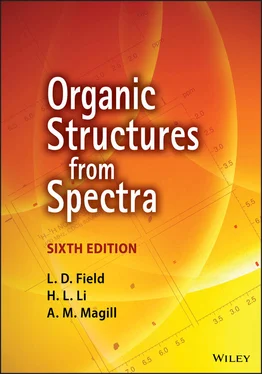1 COVER
2 PREFACE
3 LIST OF TABLES
4 LIST OF FIGURES
5 1 INTRODUCTION1.1 GENERAL PRINCIPLES OF ABSORPTION SPECTROSCOPY 1.2 CHROMOPHORES 1.3 DEGREE OF UNSATURATION 1.4 CONNECTIVITY 1.5 SENSITIVITY 1.6 PRACTICAL CONSIDERATIONS
6 2 ULTRAVIOLET (UV) SPECTROSCOPY2.1 THE NATURE OF ULTRAVIOLET SPECTROSCOPY 2.2 BASIC INSTRUMENTATION 2.3 QUANTITATIVE ASPECTS OF ULTRAVIOLET SPECTROSCOPY 2.4 CLASSIFICATION OF UV ABSORPTION BANDS 2.5 SPECIAL TERMS IN UV SPECTROSCOPY 2.6 IMPORTANT UV CHROMOPHORES 2.7 THE EFFECT OF SOLVENTS
7 3 INFRARED (IR) SPECTROSCOPY3.1 ABSORPTION RANGE AND THE NATURE OF IR ABSORPTION 3.4 IMPORTANT IR CHROMOPHORES
8 4 MASS SPECTROMETRY 4.1 IONISATION PROCESSES 4.2 INSTRUMENTATION 4.3 MASS SPECTRAL DATA 4.4 REPRESENTATION OF FRAGMENTATION PROCESSES 4.5 FACTORS GOVERNING FRAGMENTATION PROCESSES 4.6 EXAMPLES OF COMMON TYPES OF FRAGMENTATION
9 5 1H NUCLEAR MAGNETIC RESONANCE (NMR) SPECTROSCOPY 5.1 THE PHYSICS OF NUCLEAR SPINS AND NMR INSTRUMENTS 5.2 BASIC NMR INSTRUMENTATION AND THE NMR EXPERIMENT 5.3 CHEMICAL SHIFTS IN 1H NMR SPECTROSCOPY 5.4 SPIN–SPIN COUPLING IN 1H NMR SPECTROSCOPY 5.5 ANALYSIS OF 1H NMR SPECTRA 5.6 CORRELATION OF 1H–1H COUPLING WITH STRUCTURE 5.7 THE NUCLEAR OVERHAUSER EFFECT (NOE) IN 1H NMR SPECTROSCOPY 5.8 LABILE AND EXCHANGEABLE PROTONS REFERENCES
10 6 13C NMR SPECTROSCOPY 6.1 COUPLING AND DECOUPLING IN 13C NMR SPECTRA 6.2 THE NUCLEAR OVERHAUSER EFFECT (NOE) IN 13C NMR SPECTROSCOPY 6.3 DETERMINING 13C SIGNAL MULTIPLICITY USING DEPT 6.4 SHIELDING AND CHARACTERISTIC CHEMICAL SHIFTS IN 13C NMR SPECTRA
11 7 2-DIMENSIONAL NMR SPECTROSCOPY 7.1 PROTON–PROTON INTERACTIONS BY 2D NMR 7.2 PROTON–CARBON INTERACTIONS BY 2D NMR
12 8 MISCELLANEOUS TOPICS8.1 SOLVENTS FOR NMR SPECTROSCOPY 8.2 SOLVENT-INDUCED SHIFTS 8.3 DYNAMIC NMR SPECTROSCOPY – THE NMR TIME-SCALE 8.4 THE EFFECT OF CHIRALITY 8.5 THE NMR SPECTRA OF “OTHER NUCLEI”
13 9 DETERMINING THE STRUCTURE OF ORGANIC COMPOUNDS FROM SPECTRA Collection of Spectra 9.1 SOLVING PROBLEMS 9.2 WORKED EXAMPLES
14 10 PROBLEMS Problem 1 Problem 2 Problem 3 Problem 4 Problem 5 Problem 6 Problem 7 Problem 8 Problem 9 Problem 10 Problem 11 Problem 12 Problem 13 Problem 14 Problem 15 Problem 16 Problem 17 Problem 18 Problem 19 Problem 20 Problem 21 Problem 22 Problem 23 Problem 24 Problem 25 Problem 26 Problem 27 Problem 28 Problem 29 Problem 30 Problem 31 Problem 32 Problem 33 Problem 34 Problem 35 Problem 36 Problem 37 Problem 38 Problem 39 Problem 40 Problem 41 Problem 42 Problem 43 Problem 44 Problem 45 Problem 46 Problem 47 Problem 48 Problem 49 Problem 50 Problem 51 Problem 52 Problem 53 Problem 54 Problem 55 Problem 56 Problem 57 Problem 58 Problem 59 Problem 60 Problem 61 Problem 62 Problem 63 Problem 64 Problem 65 Problem 66 Problem 67 Problem 68 Problem 69 Problem 70 Problem 71 Problem 72 Problem 73 Problem 74 Problem 75 Problem 76 Problem 77 Problem 78 Problem 79 Problem 80 Problem 81 Problem 82 Problem 83 Problem 84 Problem 85 Problem 86 Problem 87 Problem 88 Problem 89 Problem 90 Problem 91 Problem 92 Problem 93 Problem 94 Problem 95 Problem 96 Problem 97 Problem 98 Problem 99 Problem 100 Problem 101 Problem 102 Problem 103 Problem 104 Problem 105 Problem 106 Problem 107 Problem 108 Problem 109 Problem 110 Problem 111 Problem 112 Problem 113 Problem 114 Problem 115 Problem 116 Problem 117 Problem 118 Problem 119 Problem 120 Problem 121 Problem 122 Problem 123 Problem 124 Problem 125 Problem 126 Problem 127 Problem 128 Problem 129 Problem 130 Problem 131 Problem 132 Problem 133 Problem 134 Problem 135 Problem 136 Problem 137 Problem 138 Problem 139 Problem 140 Problem 141 Problem 142 Problem 143 Problem 144 Problem 145 Problem 146 Problem 147 Problem 148 Problem 149 Problem 150 Problem 151 Problem 152 Problem 153 Problem 154 Problem 155 Problem 156 Problem 157 Problem 158 Problem 159 Problem 160 Problem 161 Problem 162 Problem 163 Problem 164 Problem 165 Problem 166 Problem 167 Problem 168 Problem 169 Problem 170 Problem 171 Problem 172 Problem 173 Problem 174 Problem 175 Problem 176 Problem 177 Problem 178 Problem 179 Problem 180 Problem 181 Problem 182 Problem 183 Problem 184 Problem 185 Problem 186 Problem 187 Problem 188 Problem 189 Problem 190 Problem 191 Problem 192 Problem 193 Problem 194 Problem 195 Problem 196 Problem 197 Problem 198 Problem 199 Problem 200 Problem 201 Problem 202 Problem 203 Problem 204 Problem 205 Problem 206 Problem 207 Problem 208 Problem 209 Problem 210 Problem 211 Problem 212 Problem 213 Problem 214 Problem 215 Problem 216 Problem 217 Problem 218 Problem 219 Problem 220 Problem 221 Problem 222 Problem 223 Problem 224 Problem 225 Problem 226 Problem 227 Problem 228 Problem 229 Problem 230 Problem 231 Problem 232 Problem 233 Problem 234 Problem 235 Problem 236 Problem 237 Problem 238 Problem 239 Problem 240 Problem 241 Problem 242 Problem 243 Problem 244 Problem 245 Problem 246 Problem 247 Problem 248 Problem 249 Problem 250 Problem 251 Problem 252 Problem 253 Problem 254 Problem 255 Problem 256 Problem 257 Problem 258 Problem 259 Problem 260 Problem 261 Problem 262 Problem 263 Problem 264 Problem 265 Problem 266 Problem 267 Problem 268 Problem 269 Problem 270 Problem 271 Problem 272 Problem 273 Problem 274 Problem 275 Problem 276 Problem 277 Problem 278 Problem 279 Problem 280 Problem 281 Problem 282 Problem 283 Problem 284 Problem 285 Problem 286 Problem 287 Problem 288 Problem 289 Problem 290 Problem 291 Problem 292 Problem 293 Problem 294 Problem 295 Problem 296 Problem 297 Problem 298 Problem 299 Problem 300 Problem 301 Problem 302 Problem 303 Problem 304 Problem 305 Problem 306 Problem 307 Problem 308 Problem 309
15 INDEX
16 END USER LICENSE AGREEMENT
1 Chapter 2Table 2.1 Observable UV Absorption Bands for AcetophenoneTable 2.2 The Effect of Extended Conjugation on UV AbsorptionTable 2.3 UV Absorption Bands in Common Carbonyl CompoundsTable 2.4 UV Absorption Bands in Common Benzene Derivatives
2 Chapter 3Table 3.2 C–H IR Absorption Frequencies in Common Functional GroupsTable 3.3 C≡N and C≡C Absorption Frequencies in Common Functional Groups...Table 3.4 C=O IR Absorption Frequencies in Common Functional GroupsTable 3.5 Characteristic IR Absorption Frequencies for Functional Groups
3 Chapter 4Table 4.1 Accurate Masses of Selected IsotopesTable 4.2 Common Fragments and their Masses
4 Chapter 5Table 5.1 Nuclear Spins and Magnetogyric Ratios for Common NMR-Active Nuclei...Table 5.2 Resonance Frequencies of 1H and 13C Nuclei in Magnetic Fields of Dif...Table 5.3 Typical 1H Chemical Shift Values (δ) in Selected Organic Comp...Table 5.4 Typical 1H Chemical Shift Values (δ) of Selected P...Table 5.5 1H Chemical Shift Values (δ) for Protons in Common Alkyl Deri...Table 5.7 Approximate 1H Chemical Shifts (δ) for Olefinic ProtonsTable 5.8 Approximate 1H Chemical Shifts (δ) for Aromatic Protons in Be...Table 5.9 1H Chemical Shifts (δ) for Protons in some Polynuclear Aromat...Table 5.10 Typical 1H– 1H Coupling ConstantsTable 5.11 Relative Line Intensities for Simple MultipletsTable 5.12 Proton–Proton Coupling Constants in Aromatic and Heteroaromatic Rin...
5 Chapter 6Table 6.1 The Number of Aromatic 13C Resonances in Benzenes with Different Sub...Table 6.2 Typical 13C Chemical Shift Values in Selected Organic Compounds...Table 6.3 Typical 13C Chemical Shift Ranges in Organic CompoundsTable 6.5 13C Chemical Shifts (δ) for sp3-hybridised Carbons in Alkyl D...Table 6.6 13C Chemical Shifts (δ) for sp2-hybridised Carbons in Vinyl D...Table 6.7 13C Chemical Shifts (δ) for sp-hybridised Carbons in Alkynes ...Table 6.8 Approximate 13C Chemical Shifts (δ) for Aromatic Carbons in ...Table 6.9 Characteristic 13C Chemical Shifts (δ) in some Polynuclear A ...
6 Chapter 8Table 8.1 1H and 13C Chemical Shifts for Common NMR solvents
Читать дальше












